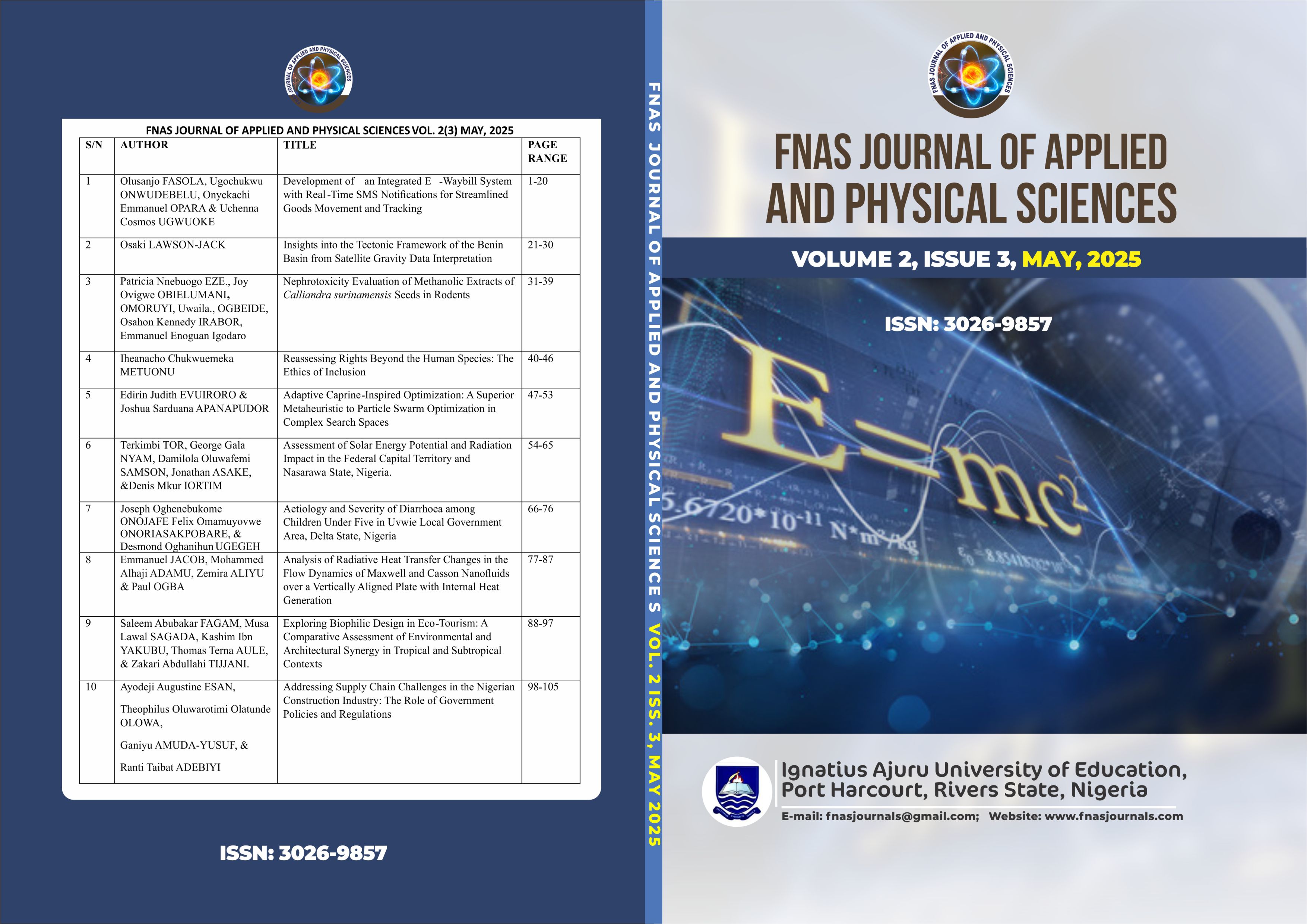Adaptive Caprine-Inspired Optimization: A Superior Metaheuristic to Particle Swarm Optimization in Complex Search Spaces
DOI:
https://doi.org/10.63561/japs.v2i3.813Keywords:
Caprine-Inspired Optimization, Particle Swarm Optimization, Metaheuristics, Complex Search Spaces, Goat Optimization AlgorithmAbstract
This paper presents the Adaptive Caprine-Inspired Optimization (ACIO) algorithm, a novel bioinspired metaheuristic grounded in the behavioural ecology of goats. Unlike earlier caprine-based models, ACIO integrates four distinct strategies: stochastic exploration, directional refinement, probabilistic jumping, and diversity preservation, into a unified framework to enhance convergence speed and maintain population diversity. Implemented in MATLAB and tested against Particle Swarm Optimization (PSO) on five benchmark functions, ACIO achieves a 50% faster convergence rate and a 78% reduction in mean fitness on the Rastrigin function. Statistical validation using the Wilcoxon rank-sum test (p < 0.05) confirms the algorithm's robustness.
References
Akbari, M. A., Zare, M., Azizipanah-Abarghooee, R., Mirjalili, S., & Deriche, M. (2022). The cheetah optimizer: a nature-inspired metaheuristic algorithm for large-scale optimization problems. Scientific Reports, 12, 10641. https://doi.org/10.1038/s41598-022-14338-z DOI: https://doi.org/10.1038/s41598-022-14338-z
Deb, K., Pratap, A., Agarwal, S., & Meyarivan, T. (2002). A fast and elitist multiobjective genetic algorithm: NSGA-II. IEEE Transactions on Evolutionary Computation, 6(2), 182-197. https://doi.org/10.1109/4235.996017 DOI: https://doi.org/10.1109/4235.996017
Fister, I., Jr., Fister, I., Yang, X. S., & Brest, J. (2021). Marine Predators Algorithm: A bio-inspired approach for engineering optimization. Expert Systems with Applications, 167, 114421.
Holland, J. H. (1992). Adaptation in natural and artificial systems (2nd ed.). MIT Press. DOI: https://doi.org/10.7551/mitpress/1090.001.0001
Hutchings, M. R., Milner, J. M., Gordon, I. J., Kyriazakis, I., & Jackson, F. (2006). Trade-offs in herbivore-parasite interactions: Insights from caprine ecology. Mammal Review, 36(1), 1-16. DOI: https://doi.org/10.1111/j.1365-2907.2006.00080.x
Kennedy, J., & Eberhart, R. (1995). Particle swarm optimization. Proceedings of ICNN'95 - International Conference on Neural Networks, 4, 1942-1948. https://doi.org/10.1109/ICNN.1995.488968 DOI: https://doi.org/10.1109/ICNN.1995.488968
Li, S., Chen, H., Wang, M., Heidari, A. A., & Mirjalili, S. (2022). Slime mould algorithm: A metaheuristic for constrained optimization. Applied Soft Computing, 113, 107843.
Lu, C. D. (1988). Foraging strategies of goats in arid landscapes: Implications for bio-inspired algorithms. Small Ruminant Research, 1(3), 205-216. DOI: https://doi.org/10.1016/0921-4488(88)90049-1
Mirjalili, S., Mirjalili, S. M., & Lewis, A. (2014). Grey Wolf Optimizer. Advances in Engineering Software, 69, 46-61. https://doi.org/10.1016/j.advengsoft.2013.12.007 DOI: https://doi.org/10.1016/j.advengsoft.2013.12.007
Mohammadi, A., & Akbari, E. (2023). Renewable energy optimization using nature-inspired metaheuristics: A 2023 review. Energy Reports, 9, 123-135.
Nocedal, J., & Wright, S. J. (2006). Numerical optimization (2nd ed.). Springer.
Nozari, H., Abdi, H., & Szmelter-Jarosz, A. (2025). Goat Optimization Algorithm: Theoretical foundations and industrial applications. Applied Innovations in Industrial Management, 5(1), 70-80. DOI: https://doi.org/10.63630/aiim.51.70
Silanikove, N. (2000). Physiological adaptations of goats to extreme environments. Small Ruminant Research, 35(3), 181-193. DOI: https://doi.org/10.1016/S0921-4488(99)00096-6
Wang, G., Deb, S., Cui, Z., & Zhang, J. (2021). A 2021 benchmark suite for testing metaheuristics: Analysis and recommendations. Information Sciences, 561, 58-87.
Yang, X. S., & Deb, S. (2020). Nature-inspired optimization algorithms (2nd ed.). Elsevier.









